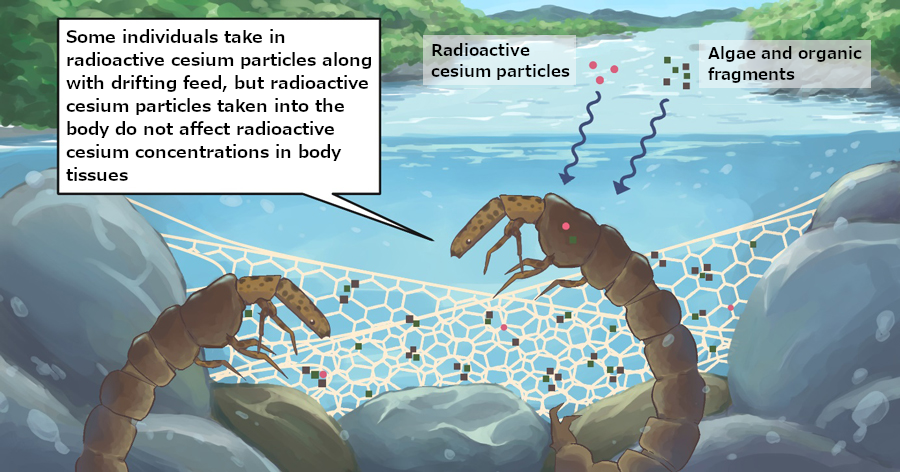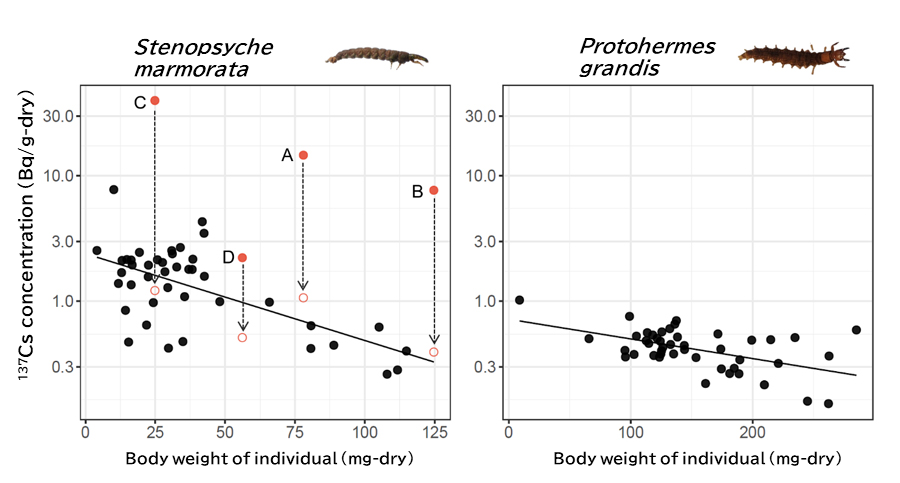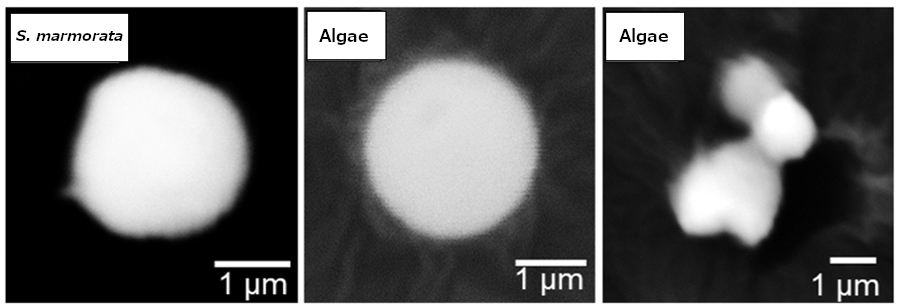Effects on Ecosystem
(2022)
QWhat kind of effects did the accident at the nuclear power station have on aquatic insects and freshwater fish that feeds on them?
AWhen aquatic insects (Stenopsyche marmorata) were collected from rivers in Fukushima prefecture and measured for radioactive cesium concentrations, radioactive cesium particles (cesium balls*1) were found in the individuals that exhibited relatively higher radioactive cesium concentrations than others. Radioactive cesium particles were also found in their feed, algae and other drifting matter. From these results, it was found for the first time in the world that radioactive cesium particles are taken into organisms and the food webs. Radioactive cesium particles are insoluble, and even if they enter into the body of organisms, it is highly unlikely that they will be taken into their body tissues such as muscles.
To understand the movement of radioactive cesium from the environment into freshwater fish, it is important to clarify radioactive cesium concentrations in aquatic insects the fish feeds on. A research team of the National Institute for Environmental Studies, Central Research Institute of Electric Power Industry, Fukushima Prefectural Centre for Environmental Creation, JAEA, National Agriculture and Food Research Organization, Fukushima University, and the Graduate School of Science, The University of Tokyo collected aquatic insects (Stenopsyche marmorata) from rivers in Fukushima prefecture and measured their radioactive cesium concentrations, and found radioactive cesium particles (cesium balls*1: cesium-bearing insoluble glass particles with a size of 0.1-10 μm) in the individuals that exhibited relatively higher radioactive cesium concentrations than others. Radioactive cesium particles were also found in their feed, algae and other drifting matter.
From these results, it was found for the first time in the world that radioactive cesium particles are taken into organisms and the food webs. Radioactive cesium particles are insoluble, and even if they enter into the body of organisms, it is highly unlikely that they will be taken into their body tissues such as muscles. Meanwhile, in a survey study for understanding the transition dynamics of radioactive cesium into the food webs, it is important to take into account the presence of radioactive cesium particles. That is because radioactive cesium in radioactive cesium particles exhibits dynamics that is completely different from water-soluble radioactive cesium in the ecosystem. In addition, if radioactive cesium particles are contained in an organism sample, it is possible that the radioactive cesium concentration of the organism ends up being overestimated. Clarifying the dynamics of radioactive cesium including cesium balls in mountain streams in the future would improve the prediction accuracy of radioactive cesium concentrations in aquatic insects and fish that feeds on them.

Schematic illustration of radioactive cesium particles taken into aquatic insects
Stenopsyche marmorata sets a net in a gap made among stones, and feeds on drifting matter that gets trapped in the net. While doing so, some take in radioactive cesium particles that get caught by their nets (4 in 46 individuals). Radioactive cesium particles taken into their bodies are released over several days, and are considered not to affect radioactive cesium concentrations in their body tissues.
Even now, 10 years after the accident at the TEPCO’s Fukushima Daiichi Nuclear Power Station, some freshwater fish have been found to have radioactive cesium concentrations exceeding 100 Bq/kg*2 in some areas of Fukushima prefecture, and shipping restrictions are still in place. It is known that most of radioactive cesium contained in freshwater fish is taken in through its feed, and to understand the movement of radioactive cesium from the environment into freshwater fish, it is necessary to clarify radioactive cesium concentrations in aquatic insects the fish feeds on.
When aquatic insects collected from Ota River in Fukushima were measured, their radioactive cesium concentrations widely varied from individual to individual. One of the suspects that came to the research team’s mind was radioactive cesium particles taken into the aquatic insects. Radioactive cesium particles are radioactive cesium-bearing insoluble particles, which are also called cesium balls*1. They have been found in various environmental samples collected in eastern Japan, but nothing has been known to date about them being taken into organisms.
In this research, the team measured radioactive cesium concentrations in two types of aquatic insects, Stenopsyche marmorata and Protohermes grandis, collected from Ota River in Fukushima in 2018. As a result, some individuals were found to have relatively high radioactive cesium concentrations, and such individuals were analyzed using autoradiography (a technique to image the distribution of radioactive materials) to check for any presence of radioactive cesium particles. If radioactive cesium particles were found, they were isolated from the insect, and were put to analyses including electron microscopy. In addition, the same procedure was applied to algae and drifting particulate matter that S. marmorata feeds on to analyze for any presence of radioactive cesium particles.
The measurement results of radioactive cesium concentrations in S. marmorata and P.grandis showed a trend of large individuals having lower radioactive cesium concentrations in both species (Figure 1). This is because radioactive cesium concentrations in the content of digestive tracts are higher than that in body tissues, and larger individuals have smaller weight ratios of the content of digestive tracts to their bodies.
Focusing on the variation in radioactive cesium concentrations, individuals with radioactive cesium concentrations about 10 times higher than other individuals were observed for S. marmorata (Figure 1, A-C), while no such variation was observed for P.grandis (Figure 1). Also, radioactive cesium particles were found in some S. marmorata samples (A-D in Figure 1). When the radioactive cesium particles were removed from them, their radioactive cesium concentrations dropped greatly. From that, the relatively high radioactive cesium concentrations observed in some S. marmorata were likely attributable to radioactive cesium particles taken into their bodies.

Figure 1 Correlation between body weight and radioactive Cs concentrations of aquatic insects
A-D (red circles) indicate samples with radioactive cesium particles found in their bodies. Outlined circles indicate radioactive cesium concentrations in body tissues after removing radioactive cesium particles.
Radioactive cesium particles were found not only in S. marmorata but also in their feed, algae and other drifting substances. When the radioactive cesium particles were analyzed using electron microscopy and other techniques (Figure 2), it was found from their sizes, elemental compositions, 134Cs/137Cs radioactivity ratios, and other properties that they were similar to radioactive cesium particles that had been reported*1. Several reports have been made on radioactive cesium particles found in various environmental samples, but this research was the first to report on radioactive cesium particles taken into organisms.

Figure 2 Electron microscopy images of radioactive cesium particles
Particles isolated from S. marmorata and algae.
While radioactive cesium particles were found in 4 out of 46 S. marmorata investigated in this research, they were not found in 45 P. grandis. This is likely caused by the difference in their feed. P. grandis is carnivorous and feeds on other smaller aquatic animals. Meanwhile, S. marmorata sets a net in a gap among stones and feeds on drifting algae and organic matter that get caught by the net. As the size of radioactive cesium particles is similar to that of the feed of S. marmorata, S. marmorata is more prone to take in drifting radioactive cesium particles along with their feed.
The results of this research suggest the possibility of radioactive cesium particles distributed in eastern Japan being taken into the aquatic and land food webs such as fish and birds via aquatic insects. Radioactive cesium particles are insoluble, and it is known that they are discharged from digestive tracts in several days even if they enter into the body of organisms, and it is highly unlikely that they will be taken into their body tissues such as muscles.
Radioactive cesium particles getting into the body of organisms cause difficulty in understanding the transition of radioactive cesium into organisms. If radioactive cesium particles are contained in an organism sample, it is possible that the radioactive cesium concentration in the organism ends up being overestimated. They may also cause major inter-individual variations in radioactive cesium concentrations, which will increase the unreliability of prediction of transition to organisms. In addition, because radioactive cesium in radioactive cesium particles exhibits dynamics that are completely different from water-soluble radioactive cesium in the ecosystem, the results of this research indicate that it is important to take into account the presence of radioactive cesium particles in understanding the transition dynamics of radioactive cesium into the food webs.
*1 Radioactive cesium particle (cesium ball) :
Insoluble glass particles with a size of around 1 μm to 1 mm that contains a relatively large amount of cesium are called insoluble cesium particles. Cesium balls are those with relatively small sizes and spherical shape.
Reference: “Q What are cesium balls? ”
(Results of a joint research with the National Institute for Environmental Studies and others)
Related articles
- How have the radioactive Cs concentrations changed in wild animals in Fukushima prefecture?
- Is there any increase in the number of mutations caused by radiation among wildlife in Fukushima prefecture?
- How have ecosystems changed in evacuation-order zones?
- Where is radioactive cesium is deposited in forests? How much? How does the amount change with time?
- How do air dose rates in forests change with time?
